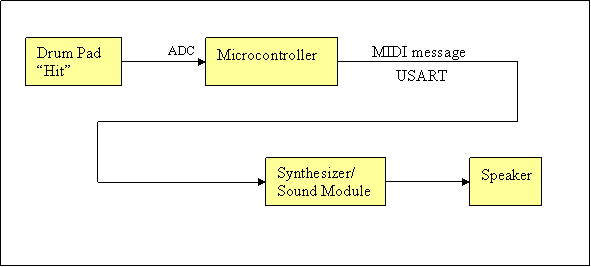MIDI DRUM CONTROLLER
ECE 476 Project -- Spring 2005
By Siew Im Low and Zheshen Zhuang
Design
[ DESIGN ]
Project Idea
Initially, we wanted to build a drum machine, which synthesize its own drum-sounds. We then learned about the MIDI protocol and the General MIDI (GM) Drum Specification from a friend who owns a music keyboard. We thought it would be more fun to be able to play “real” percussion sounds by striking physical drum pads instead of playing from the keyboard. Thus, the idea for the “ MIDI drum machine” was born.
Project Structure
An overview of our project setup is as follows:

When a drum-pad is hit, the z-axis accelerometer on the underside of the drum-pad would send an analog voltage waveform to the microcontroller. Using the ADC to track the peak voltage recorded by the drum hit, and de-bounce the “tail”, the microcontroller will then output the appropriate MIDI message through USART to a drum synthesizer or sound module to play the drum sounds. As we are using a Roland RS-70 keyboard as our sound module, we have to write our MIDI messages according to the Roland MIDI Exclusive Format for the keyboard to recognize the MIDI messages to generate the right drum sounds.
Hardware/ software Tradeoffs
Our basic drum-pads provide an alternative way of playing percussion sounds instead of playing from the keyboard. They have limited range of expressive drum performance. The drum-pads have limited velocity and volume control compared to playing percussion sounds on the keyboard. Since our simple drum-pads are small, they would not withstand drum sticks or mallets, but they would provide hours of entertainment of drum playing with fingers or hands.
Standards
MIDI (Musical Instrument Digital Interface)
MIDI is a digital communication language and hardware specification that allows multiple electronic instruments, music controllers, computers and other related devices to communicate with each other within a connected network. We specifically refer to the MIDI 1.0 Specification by the MIDI Manufacturer's Association, MMA to write our MIDI messages for detection by the RS-70 Sound Synthesizer.
The MIDI messages that are relevant in our project are the note-on, note-off, and program change message. Most MIDI messages consist of three bytes. The first byte is a status byte which identifies the message type such as note on or note off. The second byte is the value of the MIDI note of the drum triggered as shown in the GM Drum Key Map. The third byte is the velocity byte. The velocity byte denotes the loudness of a sounding note. When the velocity byte is zero, it is equivalent to a note off message.
General MIDI
General MIDI (GM) is a standard that assigns 128 instrument patches in a specific order. GM enables musicians to put Program Change messages in their MIDI song files, where the correct or originally intended instruments will be selected to play the song file. The percussive instrument patch relevant to our project is shown in the GM Patch Map with the Program Change number of 113 to 120. These numbers are used in our Program Change MIDI message.
GM Patch Map
| PERCUSSIVE | |
| Prog# | Instrument |
113 114 115 116 117 118 119 120 |
Tinkle Bell Agogo Steel Drums Woodblock Taiko Drum Melodic Tom Synth Drum Reverse Cymbal |
Usually a GM module will also have a “drum component ” with each MIDI note triggering a different drum sound. The assignments of drum sounds to specific MIDI notes are shown in the GM Drum Key Map. The drum module is usually set to receive MIDI message on Channel 10.
GM Drum Key Map
MIDI Note # Drum Sound |
MIDI Note # Drum Sound |
35 Acoustic Bass Drum 36 Bass Drum 1 37 Side Stick 38 Acoustic Snare 39 Hand Clap 40 Electric Snare 41 Low Floor Tom 42 Closed Hi-Hat 43 High Floor Tom 44 Pedal Hi-Hat 45 Low Tom 46 Open Hi-Hat 47 Low-Mid Tom 48 Hi-Mid Tom 49 Crash Cymbal 1 50 High Tom 51 Ride Cymbal 1 52 Chinese Cymbal 53 Ride Bell 54 Tambourine 55 Splash Cymbal 56 Cowbell 57 Crash Cymbal 2 |
58 Vibraslap 59 Ride Cymbal 2 60 Hi Bongo 61 Low Bongo 62 Mute Hi Conga 63 Open Hi Conga 64 Low Conga 65 High Timbale 66 Low Timbale 67 High Agogo 68 Low Agogo 69 Cabasa 70 Maracas 71 Short Whistle 72 Long Whistle 73 Short Guiro 74 Long Guiro 75 Claves 76 Hi Wood Block 77 Low Wood Block 78 Mute Cuica 79 Open Cuica 80 Mute Triangle 81 Open Triangle |
Patents/ Copyrights/ Trademarks
The Roland RS-70 owner’s manual is the copyright property of Roland Corporation. We had to refer to the manual for the MIDI Exclusive Format for our MIDI messages to be recognized by the RS-70 Sound Synthesizer. The MIDI Exclusive Format contains exclusive messages used for exchanging patches and data information between compatible devices from Roland Corporation.
Our drum controller can also use the following addtional drum patches specific to Roland RS-70.
Roland Rhythm Set Prog# Instrument Prog# Instrument 1
2
3
4
5
6
7
8
9
10
11
12
13
14
15
Standard Kit 1
Standard Kit 2
Standard Kit 3
RS Rock Kit
RS Funk Kit
RS Jazz Kit
RS Brush Kit
RS Orch Kit
R&B Kit 1
R&B Kit 2
Hip Hop Kit
Techno Kit
House Kit
Break Bts Kit
TR Kit
16
17
18
19
20
21
22
23
24
25
26
27
28
29
30
Perc Menu
Vox & Clap Menu
Fx Menu
Menu 1
Menu 2
Menu 3
GM2 Standard
GM2 Room
GM2 Power
GM2 Electric
GM2 Analog
GM2 Jazz
GM2 Brush
GM2 Orchestra
GM2 SFX
Home | Introduction | Design | Hardware | Software | Results & Conclusions | Appendix
Copyright @2005 Siew Im & Zheshen